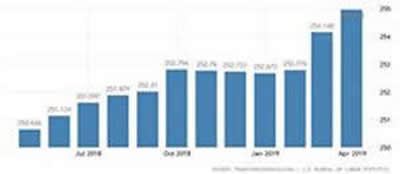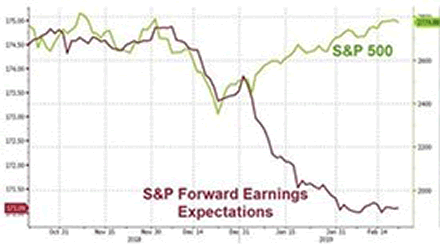Perfect Storm Brewing for Price Inflation / Commodities / Inflation
A“perfect storm” is brewing for midwestern farmers. Unending rains have led tothe flooding of tens of millions of acres of farmland. The deluge comes on theheels of years of low crop prices.
Ithas the makings of an agriculture disaster on a scale never seen before.
Thenation may see a “perfect storm” in terms of food inflation. Prices for somefarm commodities figure to be a lot higher in the months ahead as marketsadjust to dramatically lower crop yields. This will be coupled with price hikesassociated with tariffs on all manner of goods from China and elsewhere.
Totop it off, the Fed is signaling a reversal. The next move in interest ratesnow figures to be lower.
Grainand soybean prices are already on the move. Corn prices began climbing rapidlyin early May. Today the price per bushel is 20% higher than a month ago. Wheatprices are 7% above the lows of a month ago, and soybeans are 11% higher.
Chinesetariffs on U.S. agricultural products pushed prices lower earlier in the year.However, the longer-term effect of those particular tariffs may wind up beingless than many think. The market for food commodities is global and demand issomewhat inelastic.![]()
 More than a billion Chinese need tobe fed. What they don’t purchase directly from the U.S. will need to bepurchased elsewhere. We can expect to see an increase in American exports toother places.
More than a billion Chinese need tobe fed. What they don’t purchase directly from the U.S. will need to bepurchased elsewhere. We can expect to see an increase in American exports toother places.
PresidentTrump increased the tariffs on Chinese imports from 10% to 25%. Americans canlook forward to paying higher costs for many consumer goods in the monthsahead. The chart below shows recent CPI data through April.
Costcotold investors to watch for higher prices on the merchandise they sell in themost recent earnings call. The retail giant recently declared “prices will goup on things.”
FedChair Powell is using the tariffs and the prospect of price inflation asjustification for changing course. He said last week the central bank “will actas appropriate to sustain the expansion.” He and his cohorts stand ready tocombat a weakening jobs market and dwindling international trade by loweringinterest rates.
Bondyields are deeply inverted. Historically inversions of this sort have been adark omen. They often signal a recession and falling stock prices.
Giventhe central bankers’ obsession with stock prices and ongoing pressure from theTrump administration to avoid any major correction, the Fed moving preemptivelyto cut interest rates isn’t surprising.
However,it isn’t at all certain that lowering rates now can forestall what is coming.Individuals and corporations have already binged on debt. The growing mountainof borrowed money is weakening the nation’s economic prospects, not making themstronger.
Theadjacent chart is telling:
Stockprices are riding upon the “Fed Put.” There is no great earnings strengthanymore. Stock investors simply won’t sell stocks because they anticipate theFed will step in with stimulus.
Thatexpectation is 100% logical given the central bank’s track record. But logicalso dictates something else: stock prices will one day reflect earningsreality.
Iflowering rates doesn’t work to prop up stock prices, we can count on the Fed todouble down by dropping rates again or by finding even more exotic andaggressive ways to stimulate.
Thisall amounts to bad news for the U.S. dollar and for consumers who will have tocontend with higher prices.
Butthere is a silver lining for precious metals investors…
Concernsover price inflation have been absent from the markets for nearly a decade. Goldand silver markets are heavily reliant upon safe-haven demand as a key driver.With powerful inflationary forces now building, that demand looks like it’sabout to surge.
By Clint Siegner
Clint Siegner is a Director at MoneyMetals Exchange,perhaps the nation's fastest-growing dealer of low-premium precious metalscoins, rounds, and bars. Siegner, a graduate of Linfield College in Oregon,puts his experience in business management along with his passion for personalliberty, limited government, and honest money into the development of MoneyMetals' brand and reach. This includes writing extensively on the bullionmarkets and their intersection with policy and world affairs.
© 2019 Clint Siegner - All Rights Reserved
Disclaimer: The above is a matter of opinion provided for general information purposes only and is not intended as investment advice. Information and analysis above are derived from sources and utilising methods believed to be reliable, but we cannot accept responsibility for any losses you may incur as a result of this analysis. Individuals should consult with their personal financial advisors.
© 2005-2019 http://www.MarketOracle.co.uk - The Market Oracle is a FREE Daily Financial Markets Analysis & Forecasting online publication.
